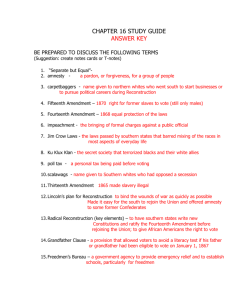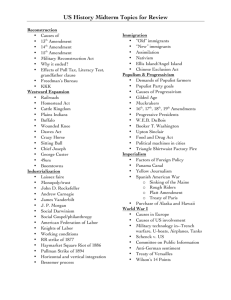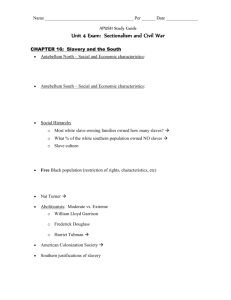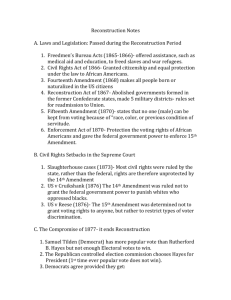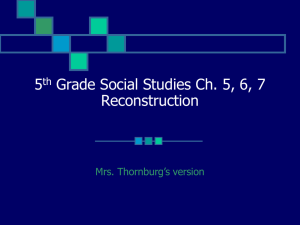Slaves to Freedmen Lesson Plan
advertisement
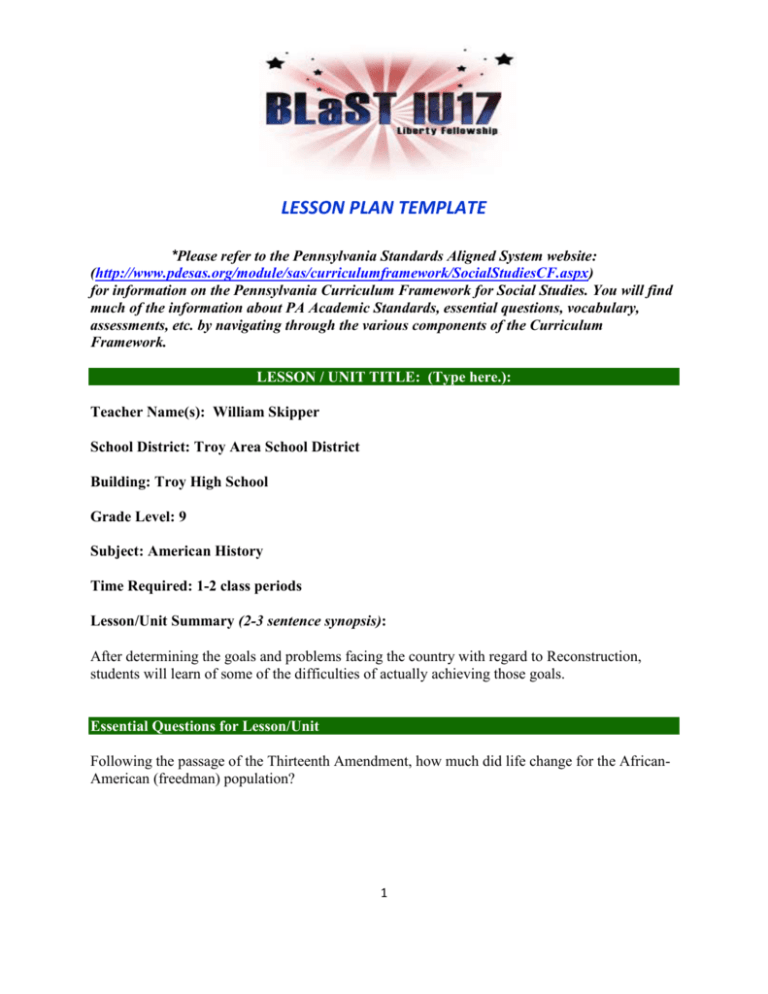
LESSON PLAN TEMPLATE *Please refer to the Pennsylvania Standards Aligned System website: (http://www.pdesas.org/module/sas/curriculumframework/SocialStudiesCF.aspx) for information on the Pennsylvania Curriculum Framework for Social Studies. You will find much of the information about PA Academic Standards, essential questions, vocabulary, assessments, etc. by navigating through the various components of the Curriculum Framework. LESSON / UNIT TITLE: (Type here.): Teacher Name(s): William Skipper School District: Troy Area School District Building: Troy High School Grade Level: 9 Subject: American History Time Required: 1-2 class periods Lesson/Unit Summary (2-3 sentence synopsis): After determining the goals and problems facing the country with regard to Reconstruction, students will learn of some of the difficulties of actually achieving those goals. Essential Questions for Lesson/Unit Following the passage of the Thirteenth Amendment, how much did life change for the AfricanAmerican (freedman) population? 1 LESSON PLAN TEMPLATE Pennsylvania Academic Standards Addressed in Lesson/Unit (Include standards numbers and standards statements.) 8.1. U.A. Evaluate patterns of continuity and change over time, applying context of events. 8.2. U.A. Evaluate the role groups and individuals from Pennsylvania played in the social, political, cultural, and economic development of the U.S. 8.2. U.D. Analyze how conflict and cooperation among groups and organizations have influenced the history and development of the United States. Lesson/Unit Objectives 1. 2. 3. 4. Define and explain the Black Codes. Describe the changes/results which took place in government during Reconstruction. Explain attempts at land reform during Radical Reconstruction. Describe different methods of opposition to Reconstruction. Vocabulary/Key Terms for Lesson/Unit Amendment Thirteenth Amendment Fourteenth Amendment Fifteenth Amendment Black Codes Freedman’s Bureau First Reconstruction Act Scalawag Carpetbagger White Leagues (KKK) Land Distribution Bill (“40 acres and a mule”) Poll tax Literacy test 2 LESSON PLAN TEMPLATE Historical Background for Teachers / Research Narrative (Insert a 2-3 page abstract that details your research on the lesson/unit topic. This is where you get to share your scholarship with your peers. You should provide enough information that a teacher could potentially teach the lesson/unit and answer general questions based on studying your narrative. Slaves to Freedmen? The end of the Civil War would obviously bring drastic changes to lives of every part of the United States and its citizens. The area most affected by these changes would be the former secessionist/slave holding states in the United States. The biggest change resulting from the war was the Thirteenth Amendment to the U.S. Constitution, proposed on January 31, 1865 (war did not end until April 9, 1865), and ratified by the states on December 6, 1865. The Thirteenth Amendment abolished slavery in the United States, effectively changing slaves into “freedmen”. Understanding that the newly freed population (and poor whites) was going to need some assistance with the transition, President Lincoln authorized the Freedman’s Bureau to begin helping in March of 1865. This bureau was designed to help with things as simple as clothing, food, and jobs as well as setting up over 40 hospitals, several thousand elementary schools, industrial institutes, and teacher-training establishments. With the implementation of the First Reconstruction Act, the Radical Republicans (who held a 2/3 majority) in Congress stated the goal of Reconstruction for the freedmen would be equality and economic independence. This was not a popular idea in the former slaveholding states of America. The goal of these people seemed to be maintenance of the status quo. Almost immediately, states began to pass “black codes” to regulate the economic and social lives of freed slaves. Politically, major changes were taking place. The “Planter Aristocracy” was being challenged by several groups who had not had political rights in those states prior to the FRA. One stipulation of the FRA was that if a state was to be readmitted to the Union, it must first ratify the Fourteenth Amendment. The third section of the Fourteenth Amendment effectively removed the right to hold office to any person who had held office prior to the Civil War, but had engaged in insurrection or rebellion, or given aid or comfort to the enemies. Others of the “Planter Aristocracy” simply refused to exercise their political rights as a misguided means of protest. By 1870, the Fifteenth Amendment had been ratified to ensure that all states allow males to vote, regardless of “previous condition of servitude”. This new political landscape led to the election of huge numbers of “carpetbaggers” (northerners who came south with mixed motives following the war), “scalawags” (anti-slavery and anti-secession southern Republicans – viewed as traitors), and “freedmen” to state and local assemblies. 3 LESSON PLAN TEMPLATE Shortly before the Fifteenth Amendment was ratified, Thaddeus Stevens’ “40 acres and a mule” plan for economic independence of the freedmen was shot down, due to the fact that there was no legal authority for confiscating the land necessary to distribute it. There were also prohibitive costs and the fear of a race war should the bill pass. There were however, huge unused plantations all over the south begging for labor, despite the reduction in the price of cotton. Hence, the system of sharecropping began. Many (most?) “black codes” required that freedmen be employed, or subject to charges of vagrancy. Since most also included clauses such as “no negro shall sell, barter, or exchange…” this meant that employment must be obtained from the white population. There were very few options for the set of skills held by freedmen, who were mostly illiterate at the time, as well. Sharecropping agreements were offered with the sugar-coated possibility of becoming an independent landowner, when the reality of the agreements signed made it nearly impossible to escape the cycle of debt that held them to that agreement year in and year out. As “carpetbagger” governments raised taxes and moved toward compulsory education for black and white, groups like the KKK rose up to combat the efforts to achieve equality by harassing Freedman’s Bureau workers, and “frightening” the freedman, carpetbag, and scalawag population from the polling booths. Eventually, in the 1876 case of U.S. v. Reese, the Supreme Court ruled that the Fifteenth Amendment did not guarantee anyone the right to vote (it just stated ways a person could not be kept from voting). This allowed the white leagues to be reinforced by literacy tests and poll taxes for new voters, almost completely eliminating political participation in politics. 4 LESSON PLAN TEMPLATE Instructional Prodedures and Activities (List/describe the step-by-step sequence of procedures and learning activities. 1. Complete assignment 12-2. (Use Attachment A, Study Guide) 2. Students will read “Development of Sharecropping in the South”, including a sample of a sharecrop agreement. a. With a partner, students will complete a compare/contrast graphic organizer, summarizing the differences and similarities between slavery and sharecropping. (Use attachment B, Graphic Organizer) b. Students will orally share those findings. 3. Students will then view Atlanta News editorial from Sept. 10, 1874 entitled “Meet Brute Force with Brute Force”, and analyze it through A.R.T.I.S.T. method. 4. Group discussion of editorial prompted by viewing of political cartoon (from Cicero) “The Ku Klux Klan and the Carpetbaggers.” Suggested Strategies for Differentiating Instruction 1. Novel: Freedom Road by Howard Fast. Assessment of Student Learning (Formative and Summative) Formative Assessment 1. Teacher observation/discussion 2. Evaluation of Study Guide assignment and completion of graphic organizer Summative Assessment 3. Five paragraph essay using the essential question as a prompt 4. Objective item quiz 5 LESSON PLAN TEMPLATE Materials and Resources (Include text, supplementary resources, primary source documents, websites, handouts, charts, maps, etc.) 1. 2. 3. 4. 5. The Americans: A History - McDougall Little Cicero (Political Cartoons and Primary Source Documents) Great Issues in American History - Beatrice K. Hofststadter An American Harvest – J.R. Conlin/C.H. Peterson Atlanta News Editorial, September 10, 1874 ( www.auburn.edu/~lakwean/hist2010/doc1874_atlnews.html ) Author(s) of Unit/Lesson Plan William Skipper, Troy Area School District, Troy High School 6
